Name: Nirali Madhabhai Dabhi
Batch: M.A Sem. 2 (2022-2024)
Enrollment Number: 4069206420220006
Roll Number: 13
Subject code: 22401
Paper Number: 108- The American Literature
Email Address: niralidabhi95@gmail.com
Submit to: Smt S.B. Gardi, Department of English, M.K.B.U
Comparing and contrasting Bob Dylan and Bruce Springsteen
Introduction of Bob Dylan:
Bob Dylan is a legendary American singer-songwriter, poet, and visual artist who was born on May 24, 1941, in Duluth, Minnesota. He rose to fame in the 1960s as a leading figure in the American folk music revival, and his music has had a profound influence on popular culture and the political landscape.
Dylan started his musical career in coffeehouses in Greenwich Village, New York City, where he developed a reputation for his thoughtful lyrics and distinctive vocal style. His early albums, such as "The Freewheelin' Bob Dylan" and "The Times They Are a-Changin'," were heavily influenced by the Civil Rights Movement and the anti-war movement, and he became known as the "voice of a generation."
Throughout his career, Dylan has explored a wide range of musical styles, from folk and blues to rock and roll and country. He has also been known for his experimentation with electric instruments, which caused controversy among his fans and the music industry in the 1960s.
Dylan's music has been recognized with numerous awards, including 10 Grammy Awards, a Golden Globe, and an Academy Award. In 2016, he was awarded the Nobel Prize in Literature "for having created new poetic expressions within the great American song tradition."
Beyond his music, Dylan is also a visual artist, with his artwork exhibited in galleries around the world. He has published several books, including the memoir "Chronicles: Volume One," which was released in 2004.
Throughout his career, Dylan has continued to inspire generations of musicians and fans with his unique voice, poetic lyrics, and social consciousness. He remains one of the most important and influential figures in American music history.
Introduction of Bruce Springsteen
Bruce Springsteen is an American singer-songwriter, musician, and producer born on September 23, 1949, in Long Branch, New Jersey. He is known for his distinctively raspy voice, his high-energy live performances, and his deeply personal and often politically charged lyrics.
Springsteen's music is characterized by its rock and roll sound, which is often accompanied by powerful and memorable lyrics that explore themes of working-class life, social justice, and the American Dream. He rose to fame in the 1970s with his third album, "Born to Run," which was a commercial and critical success and helped establish him as one of the most important musicians of his generation.
Throughout his career, Springsteen has released a number of iconic albums, including "The River," "Born in the U.S.A.," and "Darkness on the Edge of Town." He has won numerous awards, including 20 Grammy Awards, an Academy Award, and a Tony Award for his Broadway show "Springsteen on Broadway."
Beyond his music, Springsteen is also a philanthropist and activist. He has been involved in a number of social justice causes, including workers' rights and ending gun violence, and has used his music to raise awareness and support for these issues.
Springsteen's music continues to inspire generations of fans and musicians, and his live shows are legendary for their energy and intensity. He remains one of the most important and influential figures in American music history.
Musical Style
Bob Dylan and Bruce Springsteen are both known for their contributions to American music, but their musical styles are quite different.
Bob Dylan's early music was heavily influenced by folk music and blues, which he picked up during his time playing in coffeehouses in Greenwich Village in the early 1960s. His early albums, such as "The Freewheelin' Bob Dylan" and "The Times They Are a-Changin'," featured acoustic guitars and harmonicas, and his lyrics often dealt with social and political issues. However, Dylan's music later evolved to include elements of rock and roll and electric instruments, such as on his landmark album "Highway 61 Revisited" and the controversial "Blonde on Blonde." Overall, Dylan's music is characterized by his distinctive, nasal voice, poetic lyrics, and eclectic blend of musical styles.
Bruce Springsteen's music is more rooted in rock and roll, with elements of folk, soul, and R&B mixed in. His early albums, such as "Greetings from Asbury Park, N.J." and "The Wild, the Innocent & the E Street Shuffle," featured a raw, energetic sound, with Springsteen's lyrics often telling stories of working-class life and the struggles of the American Dream. As his career progressed, Springsteen's sound became more polished and produced, with albums like "Born in the U.S.A." featuring big, anthemic rock songs. Overall, Springsteen's music is characterized by his gravelly voice, passionate delivery, and ability to capture the essence of the American experience in his lyrics.
While both Dylan and Springsteen are often classified as rock musicians, their musical styles are distinct and reflect their individual influences and approaches to songwriting.
Lyrics and storytelling
Bob Dylan and Bruce Springsteen are known for their ability to tell compelling stories through their lyrics. Let's take a closer look at their individual approaches to lyrics and storytelling:
Bob Dylan's lyrics are often characterized by their poetic and enigmatic quality. He has been known to employ surrealistic and metaphorical language, which can be difficult to decipher at times. Many of his early songs, such as "Blowin' in the Wind" and "The Times They Are a-Changin'," dealt with social and political issues of the time, while others, like "Mr. Tambourine Man" and "Tangled Up in Blue," explore personal themes and relationships. Dylan's lyrics often feature themes of protest, social injustice, and love, but they are often open to interpretation, leaving listeners to draw their own conclusions about their meaning.
Bruce Springsteen's lyrics, on the other hand, are often more direct and narrative-driven. His songs frequently tell stories of working-class life and the struggles of ordinary people, often inspired by his own experiences growing up in New Jersey. Songs like "Born to Run," "Thunder Road," and "The River" are anthems of youthful rebellion and escape, while others, like "Atlantic City" and "The Ghost of Tom Joad," offer critiques of the American Dream and the plight of the working poor. Springsteen's lyrics are often characterized by their vivid imagery and emotional intensity, and he is known for his ability to capture the essence of the American experience in his songs.
While Dylan's lyrics are often more abstract and open to interpretation, Springsteen's are more grounded in narrative storytelling. However, both artists share a commitment to exploring important social and cultural themes through their music. Whether they are singing about love, politics, or the struggles of everyday life, Dylan and Springsteen are masters of using their lyrics to create powerful stories that resonate with listeners.
Comparing and contrasting
Bob Dylan and Bruce Springsteen are two of the most iconic and influential American musicians of the 20th century. While they share certain similarities in terms of their musical styles and political themes, there are also distinct differences in their approach to songwriting, performance, and cultural impact. In this essay, we will compare and contrast the careers of Bob Dylan and Bruce Springsteen.
Firstly, let us examine their musical styles. Both Dylan and Springsteen are known for their distinct voices and unique songwriting abilities. Dylan is often credited with revolutionizing folk music in the 1960s with his socially conscious lyrics and distinctive vocal style. He is also known for his use of poetic language and intricate storytelling in his songs. In contrast, Springsteen is associated with a more rock and roll sound, characterized by driving rhythms, soaring guitar solos, and anthemic choruses. His music often features working-class themes, and he is known for his high-energy live performances.
In terms of political themes, both Dylan and Springsteen have used their music as a platform to express their views on social justice and political activism. Dylan's early music was heavily influenced by the Civil Rights Movement and the anti-war movement, and his songs often dealt with themes of social inequality and injustice. Springsteen, on the other hand, has been vocal about his support for workers' rights and economic equality. Many of his songs deal with the struggles of the working class and the impact of economic inequality on American society.
Another important difference between Dylan and Springsteen is their cultural impact. Dylan is widely regarded as one of the most important and influential musicians of the 20th century, with a career that spans over six decades. He has been recognized with numerous awards, including the Nobel Prize in Literature in 2016. Springsteen, while also highly acclaimed, has had a more limited impact on popular culture. However, his influence can be seen in the work of many contemporary musicians who have been inspired by his unique style and social activism.
In terms of their approach to performance, there are also notable differences between Dylan and Springsteen. Dylan is known for his introspective and often understated performances, preferring to let his lyrics speak for themselves. Springsteen, on the other hand, is famous for his high-energy live shows, which often feature elaborate stage sets and theatrical performances.
Songs of both Bob Dylan and Bruce Springsteen
Bob Dylan and Bruce Springsteen are both highly regarded for their extensive catalogs of memorable and influential songs. Let's take a closer look at some of their most iconic songs:
Bob Dylan:
"Blowin' in the Wind": One of Dylan's most famous protest songs, "Blowin' in the Wind" was a major hit in the early 1960s and became an anthem of the civil rights movement.
"Like a Rolling Stone": A six-minute epic that redefined the possibilities of pop music, "Like a Rolling Stone" is considered one of Dylan's greatest achievements and a landmark of the rock era.
"Tangled Up in Blue": A complex, multi-layered song that reflects on a failed relationship, "Tangled Up in Blue" is widely regarded as one of Dylan's greatest compositions.
"Mr. Tambourine Man": A psychedelic-tinged classic that celebrates the power of music and imagination, "Mr. Tambourine Man" has been covered by countless artists over the years and remains a beloved song to this day.
"The Times They Are a-Changin'": Another of Dylan's most famous protest songs, "The Times They Are a-Changin'" is a stirring call to arms for social justice and political change.
Bruce Springsteen:
"Born to Run": An epic ode to youthful rebellion and escape, "Born to Run" is one of Springsteen's most iconic songs and a cornerstone of his live shows.
"Thunder Road": A cinematic, romantic ballad that tells the story of a young couple trying to escape their dead-end lives, "Thunder Road" is considered one of Springsteen's greatest songs.
"The River": A powerful reflection on the struggles of working-class life and the loss of youthful dreams, "The River" is a haunting and emotional masterpiece.
"Dancing in the Dark": A propulsive, synth-driven pop song that became one of Springsteen's biggest hits, "Dancing in the Dark" is an irresistible party anthem.
"Born in the USA": A scathing critique of American society and the treatment of veterans, "Born in the USA" is often misinterpreted as a patriotic anthem, but is actually a deeply political song.
Both Bob Dylan and Bruce Springsteen have written countless other iconic songs, but these examples give a sense of their individual styles and themes. Dylan's songs are often poetic and enigmatic, while Springsteen's are more narrative-driven and grounded in everyday life. Both artists have made important contributions to the history of popular music, and their songs continue to inspire and resonate with listeners today
Conclusion
While Bob Dylan and Bruce Springsteen share certain similarities in terms of their political themes and commitment to social justice, they also have distinct differences in their musical styles, cultural impact, and approach to performance. Both musicians have had a significant impact on American music and culture, and their legacies continue to influence artists around the world today.
(Word count- 1990)





















